CHAPTER FOUR
About one million years ago, our Sun, then a Super Sun, underwent a nova eruption because of a sudden or unendurable change in electrical conditions. Solaria Binaria was instantly born. The Sun fissioned and in a huge blossoming cloud there would have been found a diminished Sun. Within a concentration of gases from the old sun would occur an admixture of chunks of the old Sun's interior material (nucleus), including a body that became the binary partner, which we here call Super Uranus. Between the new Sun and Super Uranus lingered other fragments of the fission and great quantities of the material that were to be absorbed into the planets. This impressive electrical quantavolution occurred in a matter of hours. The separation of the two bodies increased rapidly.
In electrical and chemical terms, we begin to detail this quantavolution. The normal flow of electricity between a star (the cavity) and the surrounding space is inward as is shown in Figure 6. The original Super Sun was such a star transacting quietly with the electron-rich space around it. The Super Sun became unstable, as outlined in Chapter Three, when its galactic journey carried it into a less electron-rich region [28] . Here, the enrichment presumably was rapid and of great magnitude, producing a quantavolution. The resulting nova, which is an explosion of electrons that forces (requires) a material accompaniment, created Solaria Binaria. The Sun for a short time was relatively too electron-rich. In an explosive expansion the binary was born, not just from the solar atmosphere but also from the refractory materials normally hidden within its interior.
Figure 6. Electron Flow from Surrounding Space into a Star-cavity
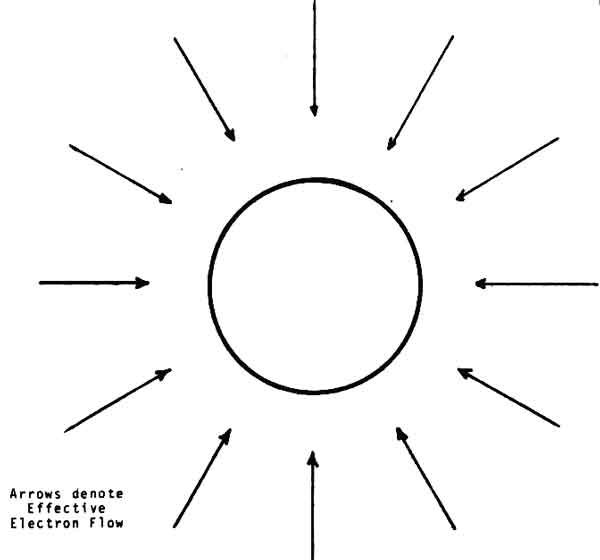
The Sun and the other stars represent electron deficient regions within the Galaxy. These regions, cavities as we call them, transact with the space around them gaining electrons during the lifetime of their central stars. When they become filled the stars they contain cease to exist.
The first state of Solaria Binaria is shown in Figure 7 below. The nova explosion had propelled what temporarily was excess charge away from the Sun. This of course would be illusory, for the Sun, by its continued existence, remained a region of relative electron deficiency. Thus, the initial dismemberment of the original Super Sun quickly halted: the expansion of the => plenum of material, now surrounding the Sun, ceased both because of the Sun's need for electrons and because the charged surrounding medium continued moving because the charged surrounding medium continued moving in upon the cavity. The boundary of the plenum shown above is actually a quantitative concept to denote the region where the outward pressure created by the charged Solaria Binaria is equal to the inward pressure normally produced by the Sun's galactic cosmic transaction.
At birth the electrical state of Solaria Binaria was radially layered. The system can best be described in terms of the local charge density of both the material and of the space into which the material was ejected in the eruption. The highest relative charge density existed at the perimeter of the plenum. Inwards this density decreased. The fragments ejected from the Sun, the debris forming the planets and Super Uranus, had progressively higher charge densities than the Sun, which had the least charge density in the system.
The Sun seeks its lost charge. The easiest way to get that charge is to launch into the plenum electron-deficient atoms (ions). The proximity of super Uranus distorted greatly what otherwise would have been a radial flow of ions (as in the original transaction between the Super Sun and the Galaxy). A strong electrical connection coupled the Sun and Super Uranus; a lesser connection joined the Sun to the plenum, as shown in Figure 8 (see Technical Note E). This connection involved an inward flow of charge through the plenum. The charge flowed inwards either by direct transport of electrons or by indirect electron transport accomplished through the outward flow of electron deficient atoms (ions) (see Technical Note B).
Figure 7. The Birth of Solaria Binaria
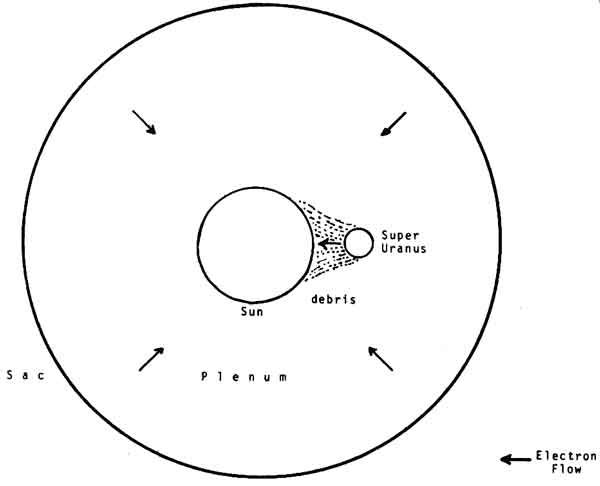
At its birth Solaria Binaria was embedded at the center of a plenum filling a sac of electron deficient matter. Electron flow into the sac from the Galaxy was augmented by electron redistribution within the plenum and among the components of the binary system.
The strongest electrical transaction occurred between the principals; accompanying this electrical flow, and highly influenced by it, was the transfer of material from one of the principals to the other. Elsewhere, close binary systems exist where the flow is form the companion to the primary (Cowley et al., 1977, p471); more common is the flow from the primary to the companion (Mitton, p85, p100). The amount of flow and its direction would depend upon the distance between and the => specific charge ratio on the principals. We favor the flow of ions and gas from the Sun to Super Uranus. Since we often cannot resolve the principals into separate stars, designation of one as the primary and the other as companion is somewhat arbitrary. The choice usually is dictated by theory.
Figure 8. Material Flow Coupling the Sun, Super Uranus, and the Electrified Plenum.
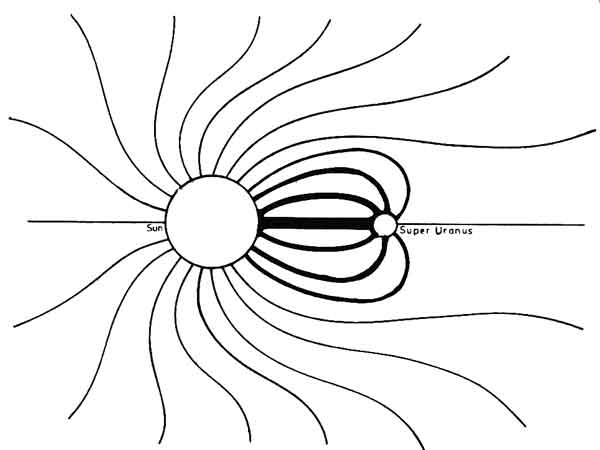
The creation of the Sun's companion, Super Uranus, greatly distorted the electrical flow between the electron deficient Sun and the Galaxy. The Sun's daughter, Super Uranus, like its parent, was short of electrons compared to galactic space outside the sac. The electrical flow coupling both the two stars and the stars with the Galaxy caused and directed a significant material exchange between the pair of stars.
Ionized gas atoms would be induced to flow between the principals. This flow of countermoving electrons and electron-deficient atoms would constitute a strong electrical current. As a consequence an intense magnetic field would be generated surrounding the current. This magnetic field would pinch the flowing ions producing a relatively narrow electrical flow channel (Zirin, p481). Collisions between neutral and electrified atoms would transfer the influence of the magnetic field (which affects only the electron-deficient atoms directly) to all of the gas between the principals; the result is a magnetic bottle (see Arp, pp213-5).

Electrically charged material flowing between the Sun and Super Uranus generated a strong magnetic field about the axis between the two stars. The effect of the magnetic field was to squeeze all material flow into a thin tube joining the stars. So constrained, the charged matter flow constituted a potent electric discharge, the arc, through the gases and matter of the plenum.
From the solar wind protons moving past the Earth, Juergens (1977c, p28) has calculated the current flowing away from the Sun in a sheet localized close to the ecliptic plane. If this same ion current was once flowing through the electrical channel, then the magnetic field generated was several thousand gauss in strength. Such a field would adequately constrain most of the gases producing a gaseous column or axis between the two stars. Material has been found along the interstellar axis in several binary systems (Batten, 1973a, p5).
The absence of an appreciable interplanetary magnetic field despite the magnitude of the electric current represented by today's solar wind is understandable in terms of a planar current sheet model.
Figure 10 Magnetic Toroidal Field Produced by Solar Wind Current Sheet
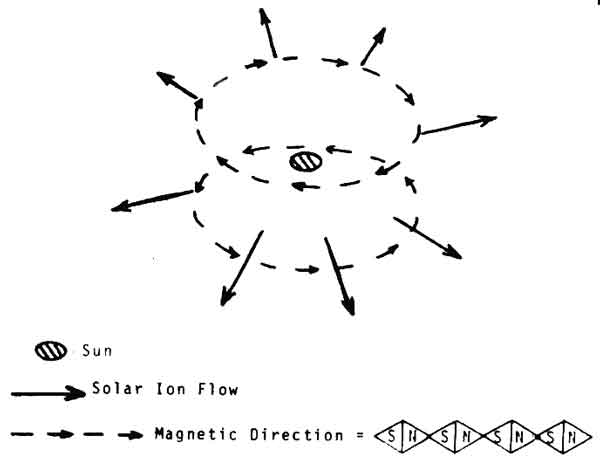
Assuming that the solar wind is concentrated about the plane of the orbiting planets, the outward flow of ions from the Sun would represent a sheet of electric current. A significant magnetic field, curved upon itself to form a doughnut (a torus), would be generated by the existence of the solar current sheet. This toroidal magnetic field should be found in the space above and below the space occupied by the solar wind.
As shown in Figure 10, the solar wind sheet produces opposed toroidal (doughnut-shaped) magnetic regions above and below the planetary plane of motion. In the region between the toroids the magnetic fields generated by the radially diverging ions act so as to cancel out one another as in Figure 11. The vector sum of the magnetic intensity cancels between the parallel flowing ions but survives on their perimeter, leaving the postulated toroidal field. So, the regions above and below the Sun could be strongly magnetic, while interplanetary space so far explored lies outside of the toroidal field region, and has been shown to be almost devoid of magnetism. The existence of the magnetic toroid above and below the Sun may be responsible for the planarity of today's planetary region and the enhancement of the solar wind flow in that plane.
The Sun's rotation began consequent to the nova discharge creating Super Uranus, Super Uranus thereafter wheeled about the Sun in close orbit. The magnetic field produced by their electrical transaction was instrumental in locking the rotation of the Sun to the motion of Super Uranus about the Sun. Strongly coupled together the pair rotated looking like an ever expanding but otherwise rigid dumb-bell. The gases and the planets as they formed remained trapped along the gaseous electrified axis between the principals.
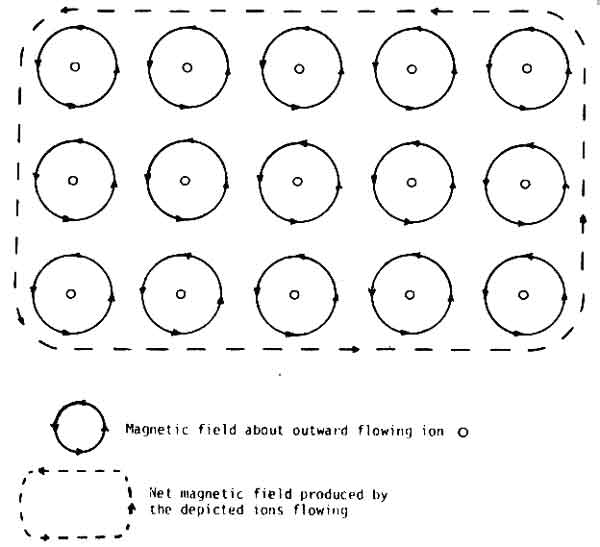
Each moving ion (or electron) comprises a unit of electrical current. It generates a magnetic field which appears in the plane perpendicular to its motion. When electrical charges flow radially, as does the ion wind from the Sun, only a tiny magnetic field is apparent in the region between the flowing ions because the magnetic effect of each ion is cancelled by that of its neighbors. A significant magnetic indication of the electrical flow is found only along the perimeter of the current sheet produced by the radial flow of the ions.
Plavec notes that the companion, if less massive than the Sun, can always be expected to rotate in synchronism with orbital motion. He states, also, that for all binary systems synchronism of rotation and revolution seem to occur for orbital periods shorter than ten days. For longer periods the synchronism falls except as postulated above.
Batten (1967, p36) notes that some semi-detached binary systems, particularly the Algol group, have primaries which rotate appreciably faster than would be expected for orbital synchronism [29] . We see these systems as a later stage of evolution of the binary. Solaria Binaria did not detach in this way until after the Saturnian period (see ahead, Chapter Fourteen).
The evolution of Solaria Binaria was such that the two principals were slowly driven apart, in part by the momentum of the flow of mass from one to the other and in part from increased repulsion caused by the growing level of electric charge in the whole system by the accumulation of galactic electrons. All the while the angular momentum (spin) within the system was being transferred from the primary to its companion. At fission the Sun could have had over 80 percent of the angular momentum. The evolved binary (today's Solar System) left less than one percent of the angular momentum in the Sun. If matter was transferred mechanically from the heavier Sun to the lighter orbiting Super Uranus, the spin of the binary would decrease, but if the transferred matter is electrically driven, acceleration would be expected to accompany the transfer, thereby potentially increasing the spin of the binary. Even if no increase in spin occurs and even with a slight slowdown of spin, angular momentum is slowly lost by the Sun and gained by its companion and the primitive planets as the electric transfer continues.
The pulling apart of the principals was reflected in an increase in the binary's period of revolution. That is, Solaria Binaria wheeled more slowly about its center. There is a significant relation between the period of revolution of binaries and the observed "surface temperature" of the primary star. Certain stars called => early-type by astronomers tend to have companions with shorter periods (Russell et al., 1927, pp703ff).
In its earlier stages, Solaria Binaria would have looked to a distant observer as a close binary with an unseen companion. We imply that the Sun was an early-type star but not in the usual sense of the term star. Within the => sac, where the two stars and the Earth were located, the energy flow may always have been similar to what we observe now. However the outer parts of the sac were transacting intensively with the cosmos and thus were radiating so as to appear markedly hotter. The perimeter of Solaria Binaria, then, would have appeared to radiate as an early-type star and not like the Sun does now (see ahead to Figure 21). Its period of light variation, radiation emitted, and flow of mass would have attracted the attention of astronomers elsewhere to Solaria Binaria.
Some curious "age disparities" exist between principals of binary systems. In the Sirius star system, a young => main sequence star is orbited by a less massive old white dwarf star (see Kopal, 1938). The B-emission stars (hot, very rapidly rotating main sequence stars surrounded by a shell of gas) are often spectroscopic binaries whose companions orbit in about ten days. The companion is usually invisible and believed to be a highly => evolved star relative to the primary (Maraschi et al.). The highly evolved component admittedly often has so little mass that a nuclear synthetic evolution (see => nucleosynthesis) could no have aged it so rapidly (Kraft).
Both the age disparities and the size anomalies disappear if electrical evolution is considered. It is noteworthy that many of the interesting close-binary systems involve an unseen companion. The primaries in these systems range from very hot-type O-stars to very-cool-type M-stars. The sizes and masses within these star systems are inferred conventionally from the theory of evolution for the thermonuclear star (see => thermonuclear fusion). We do not agree with such an interpretation of this evidence.
We will not pursue the stages of early evolution of Solaria Binaria here (for that, see Part Two). The first aware men saw the skies in the => Age of Urania about thirteen thousand current years before the present (de Grazia, 1981). There were no humans capable of comprehending Solaria Binaria before it began to break up at the end of an Earth age that we shall be calling Pangea.
Super Uranus was first revealed to humans as a luminous object about twice the size of the Sun we observe today. The Earth was then located about two-thirds of the distance from the Sun to Super Uranus, because it was still electromagnetically bound to the axis between the stars. The objects found within the inner regions of galaxies seemingly orbit in this way - and probably for the same reason.
With such a configuration the Sun, if visible, would have been seen from the Earth's southern hemisphere only and would appear 2.5 times larger than Super Uranus, which in its turn was visible only from the northern hemisphere. The hemispheres referred to here are not those inscribed on the Earth - globes of today. They refer to the ancient references to the sky gods and their places. The Earth moved with its "north" locked towards Super Uranus (see ahead to Figure 18). No other major gaseous planet was in existence at this time. As the solid-wheel binary evolved, the Sun eventually was separated from Super Uranus by 105 gigameters (about 0.7 astronomical units). Before the next great quantavolution the primitive planets Mars, Earth, Apollo, and Mercury ended up between the two principals in the region between 61 and 96 gigameters from the Sun. At such separation this would this would bring the planets Mars and Mercury closer to Earth by factors of four and six respectively. Even so these planets would produce visible discs which were only about one twenty-seventh the size of today's Moon. If they could be seen (which we doubt) they would still be observed almost as points of light in the sky [30] .
The planets were originally debris from the Super Sun nova. They traveled out in the trail of Super Uranus, held in the electric and gaseous flow. They settled into their original positions rather than moving on because they were electrically less negative than Super Uranus. They distributed themselves in their magnetic cage along the axis in accord with the principle of maximum mutual repulsion (elsewhere known as "the principle of least interaction action"; see Ovenden, 1974).
Several cosmogonies involve processes occurring within a binary star system. Gunn proposes that planets arise from the break-up of a rotationally unstable star, the same process by which he accounts for the formation of a binary star system from a single star. Lyttleton (1936, p559) visualizes a process by which planets form during an encounter of a star with two other stars; for such an encounter between three stars to be likely the stars must formerly be members of a bound system of stars, a triple star system. Bruce (1944, p13), like Gunn, sees the process of planet formation as a special case of fission of one star into a binary.
From the beginning Solaria Binaria was enveloped in a cloud of solar material (gases and solids). As the binary evolved this sac became extended along the lengthening axis from Sun to Super Uranus. Compressed by the magnetic field generated by the flowing electrified gases, a stable gaseous tube surrounded the planets; indeed these gases pervaded the entire planetary region, enveloping all of the planets in a single sac of gases. Within this dense gaseous sac, the contents of which the ancients called the aether [31] , and we will call the plenum, the planets could receive biologically necessary temperatures from the axial electrical discharge connecting the Sun with Super Uranus (de Grazia, 1981). If today's aircraft had existed then, they might have flown regularly among the planets.
The approximate size of the gaseous tube within which the Earth and the other planets moved was at most the diameter of the Sun, and at the least a significant fraction of the diameter of Super Uranus. This tube confined the plenum which allowed life to develop and thrive on all of the planets of Solaria Binaria.
Notes on Chapter 4